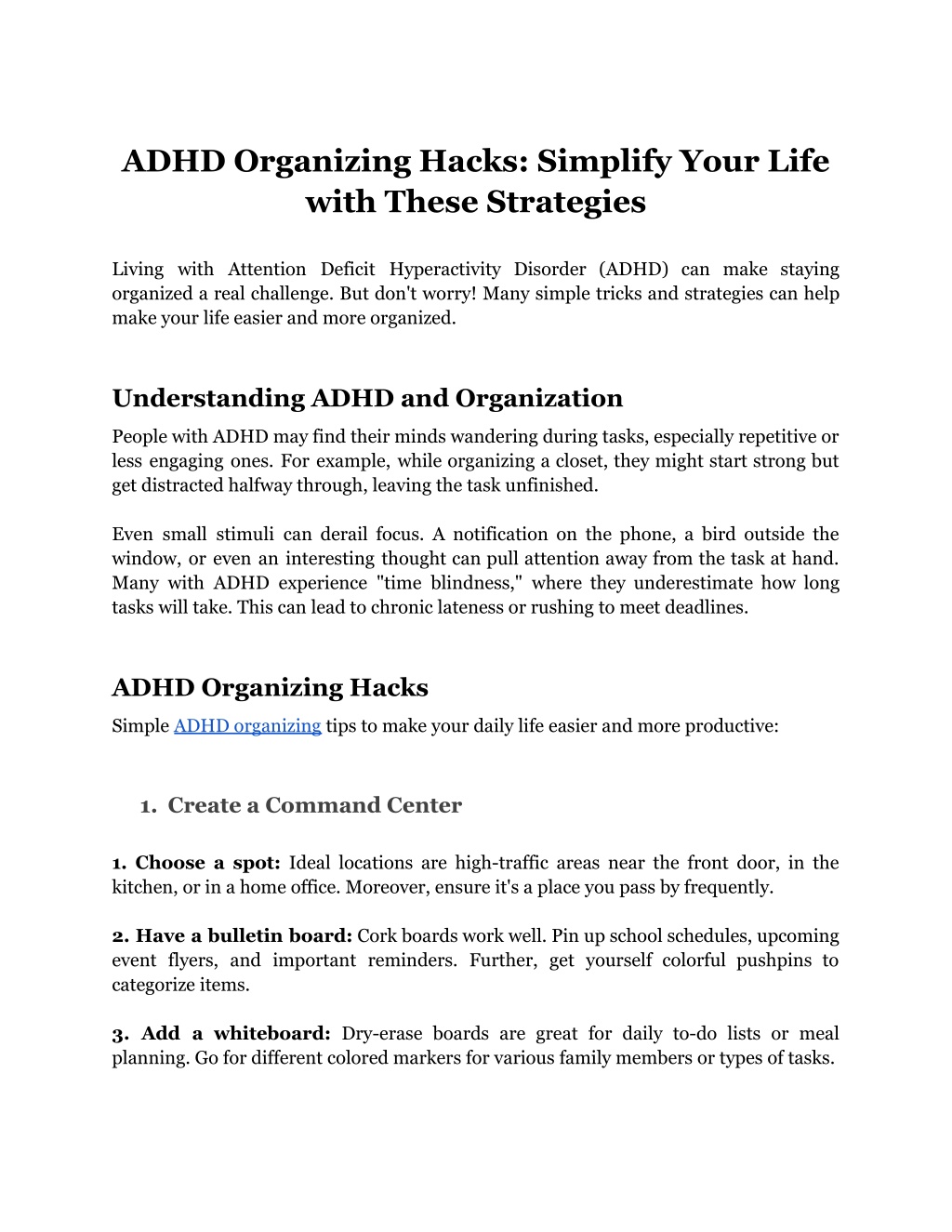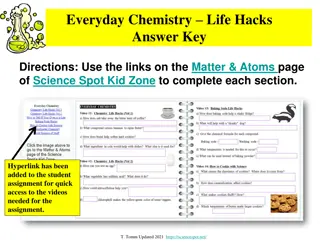
ADHD Organizing Hacks_ Simplify Your Life with These Strategies
Use your bank's bill pay service or set up automatic paymentsnwith decluttering services. Keep a master list of all auto-pay arrangements for easynreference.
Download Presentation

Please find below an Image/Link to download the presentation.
The content on the website is provided AS IS for your information and personal use only. It may not be sold, licensed, or shared on other websites without obtaining consent from the author. Download presentation by click this link. If you encounter any issues during the download, it is possible that the publisher has removed the file from their server.
E N D
Presentation Transcript
ADHD Organizing Hacks: Simplify Your Life with These Strategies Living with Attention Deficit Hyperactivity Disorder (ADHD) can make staying organized a real challenge. But don't worry! Many simple tricks and strategies can help make your life easier and more organized. Understanding ADHD and Organization People with ADHD may find their minds wandering during tasks, especially repetitive or less engaging ones. For example, while organizing a closet, they might start strong but get distracted halfway through, leaving the task unfinished. Even small stimuli can derail focus. A notification on the phone, a bird outside the window, or even an interesting thought can pull attention away from the task at hand. Many with ADHD experience "time blindness," where they underestimate how long tasks will take. This can lead to chronic lateness or rushing to meet deadlines. ADHD Organizing Hacks Simple ADHD organizing tips to make your daily life easier and more productive: 1. Create a Command Center 1. Choose a spot: Ideal locations are high-traffic areas near the front door, in the kitchen, or in a home office. Moreover, ensure it's a place you pass by frequently. 2. Have a bulletin board: Cork boards work well. Pin up school schedules, upcoming event flyers, and important reminders. Further, get yourself colorful pushpins to categorize items. 3. Add a whiteboard: Dry-erase boards are great for daily to-do lists or meal planning. Go for different colored markers for various family members or types of tasks.
4. Include a calendar: A large wall calendar with ample writing space for each day works best. You can have it to track appointments, deadlines, and family activities. Color-code entries for easy visual reference. 5. Make a charging station: Use a multi-port USB charger and short cables to keep all devices in one place. Label each cable to avoid confusion. 6. Baskets or folders: Label clearly with categories like "Bills to Pay," "To File," "School Papers," etc. Empty and sort these regularly to prevent overflow. 7. Keep it tidy: Implement a "one in, one out" rule. When you add something new, remove an old item. Spend 5 minutes each day tidying the command center. 2. Simplify Your Wardrobe 1. Hanger trick: At the start of a season, turn all hangers backward. After wearing an item, return it with the hanger facing forward. After 3-6 months, consider donating unworn items. 2. Create a capsule wardrobe: Choose 30-40 versatile pieces that can be mixed and matched. Include basics like solid-colored tops, versatile bottoms, and a few statement pieces. 3. Organize by color: Arrange clothes from light to dark within each category (e.g., shirts, pants). This creates a visually pleasing gradient and makes it easier to find specific items. 4. Drawer dividers: Invest in adjustable drawer organizers. Fold smaller items like socks, underwear, and t-shirts using the KonMari method to maximize space and visibility. 5. Plan outfits ahead: On Sunday evening, choose 5-7 outfits for the week. Hang complete outfits together or use shelf dividers to separate them. 6. Keep a donation box: Place a small box or bag in your closet. Whenever you try on something that doesn't fit or you don't like anymore, put it directly in the donation box.
3. Tame Your Paperwork 1. Go digital: keep a scanner app on your smartphone to quickly digitize documents. Create a logical folder structure on your computer or cloud storage for easy retrieval. 2. Filing system: Invest in a small filing cabinet or accordion file. Create broad categories like "Taxes," "Medical," "House," and "Car." you can have a colored folder for easy identification. 3. Handle mail right away: Set up a mail station with a recycling bin, shredder, and sorting tray. Open mail near this station and immediately sort into "Act Now," "File," or "Toss." 4. Use a shredder: Shred any documents with personal information like social security numbers, account numbers, or signatures before disposing. 5. Set up auto-pay: Use your bank's bill pay service or set up automatic payments with decluttering services. Keep a master list of all auto-pay arrangements for easy reference. 6. Receipt app: Apps like Expensify or Receipt Bank can categorize and store digital copies of receipts. Some can even extract key information automatically. 4. Make Your Kitchen Work for You 1. Clear containers: Invest in a set of stackable, airtight containers. Transfer dry goods like flour, sugar, and pasta into these for easy visibility and freshness. 2. Label everything: have a label maker or write clearly on masking tape. Label not just containers, but also shelves and drawers to create "homes" for items. 3. Group similar items: Create zones in your kitchen. For example, a baking zone with flour, sugar, and measuring cups; and a breakfast zone with cereals, bread, and spreads. 4. Meal planning board: Create a weekly menu board using a small whiteboard or chalkboard. Include a section for your grocery list to streamline shopping.
5. Keep counters clear: Put hooks for cups or cutlery under the cabinets. To hang pots and pans, use a pegboard. Appliances that you use less than once a week should be kept in cupboards. 6. Drawer organizers: Invest in expandable drawer organizers for utensils. Store loose objects in deeper drawers by organizing them with little baskets or boxes. 7. Clean as you go: Keep a sink caddy with dish soap, sponge, and brush. Wash prep tools while food is cooking. Wipe down surfaces during short breaks in food prep. 5. Simplify Cleaning 1. Make a cleaning schedule: Assign specific tasks to days of the week. For example, Monday for bathrooms, Tuesday for vacuuming, etc. Break larger tasks into smaller, daily chunks. 2. Use a timer: Set a timer for 20 minutes of cleaning followed by a 10-minute rest (the "20/10" approach). This keeps burnout at bay and gives the work a more doable sense. 3. Establish a spot for everything: When bringing new things home, adhere to the "one in, one out" approach. Check frequently to see if everything is in the most sensible and convenient places. 4. Do one room at a time: Focus on completing one area before moving to the next. This provides a sense of accomplishment and prevents half-finished jobs throughout the house. 5. Keep cleaning supplies handy: Create small cleaning caddies for each floor or room. Stock with multi-surface cleaner, microfiber cloths, and other essentials. 6. Declutter regularly: Schedule monthly decluttering sessions! Focus on one category at a time (e.g., books, clothes, kitchen gadgets) rather than tackling entire rooms. 6. Manage Your Time Better
1. Have a Planner: Choose a planner that fits your style and for this go for the paper or laptop. Include space for daily tasks, appointments, and long-term goals. Color-code different types of activities. 2. Try time-blocking: Assign specific timeframes to tasks. For example, 9-10 AM for emails, 10-11 AM for focused work, etc. Include breaks and buffer time between blocks. 3. Set alarms: Use your phone's alarm function not just for waking up, but for task reminders throughout the day. Set alarms for starting and stopping tasks to improve time awareness. 4. "2-minute rule": If a task takes less than two minutes (e.g., replying to a quick email, or putting away a book), do it immediately rather than adding it to your to-do list. 5. Break big tasks into smaller steps: For large projects, create a detailed breakdown of smaller tasks. Schedule these smaller tasks across several days or weeks. 6. Pomodoro Technique: Work in focused 25-minute sessions followed by 5-minute breaks. After four "Pomodoros," take a longer 15-30 minute break. 7. Avoid multitasking: Focus on one task at a time! Close unnecessary browser tabs, put your phone on "Do Not Disturb," and create a distraction-free environment for important tasks. 7. Create Effective To-Do Lists 1. Keep it short: Limit your daily list to 3-5 "must-do" items. These should be your most important or time-sensitive tasks. 2. Be specific: Instead of "work on the project," write actionable steps like "draft project outline" or "research three sources for the project." 3. Prioritize: Use a system like the Eisenhower Matrix to categorize tasks by urgency and importance. Focus on tasks that are both urgent and important first. 4. Divide into categories: Group tasks into categories like "Work," "Personal," "Errands," etc. This helps in batch-processing similar tasks and provides a clearer overview of your responsibilities.
5. Include easy tasks: Add a few quick, simple tasks that you can complete easily. Checking these off provides a sense of accomplishment and momentum. 6. Review and update: Spend 5-10 minutes each evening reviewing your list for the next day. Move unfinished tasks forward and add new items as needed. 7. Try a "done" list: Keep a separate list of completed tasks. This provides a visual record of your accomplishments and can be motivating on days when you feel unproductive. 8. Go for Visual Cues 1. Sticky notes: Place brightly colored notes in key locations as reminders. For example, put a note on your bathroom mirror to remember medication or on the front door to remember your lunch. 2. Create a vision board: Use a cork board or digital tool like Pinterest to create a collage of images representing your goals. Place this where you'll see it daily for motivation. 3. Color-coding: Assign colors to different types of tasks or events in your calendar. For example, blue for work tasks, green for personal appointments, and red for deadlines. 4. Make things visible: To keep often-used goods visible, utilize open shelves or clear storage containers. Use desktop file organizers in the office to maintain visibility of ongoing tasks. 5. Draw mind maps: Use large sheets of paper or a digital tool like MindMeister to visually brainstorm ideas or plan projects. This can help in seeing connections and organizing thoughts. 6. Visual timers: Try a Time Timer or a similar app that shows time elapsing visually. This can be especially helpful for staying on task or managing time during activities. 7. Create a "done" jar: Write accomplishments on slips of paper and add them to a clear jar. Watching the jar fill up provides a visual representation of your progress and can be very motivating.
Conclusion Remember, implementing these strategies is a process. Start with one or two that resonate most with you and gradually incorporate more as you build new habits. The key is to find what works best for your unique needs and lifestyle. Achieve your dream of a tidy life with Before & After Organizing by Jan. Visit us for expert decluttering services that transform your space into a functional and serene environment.






















